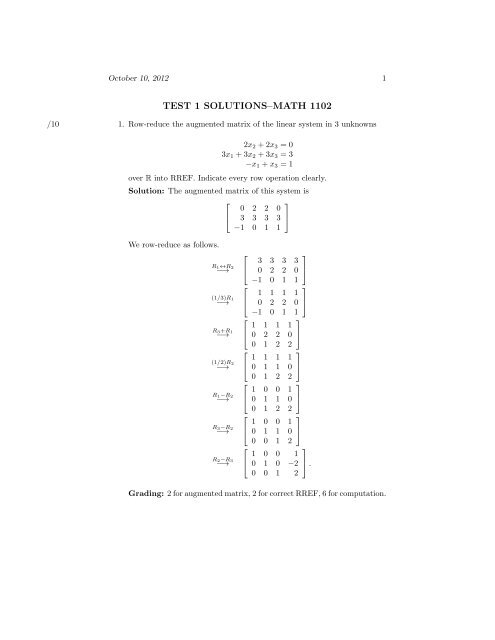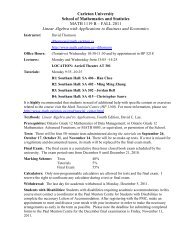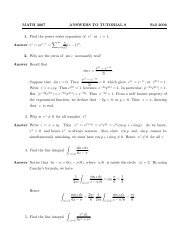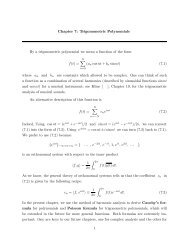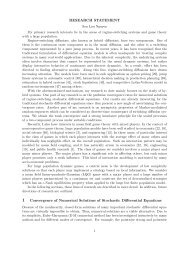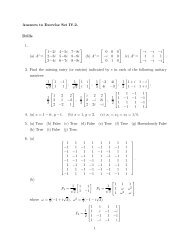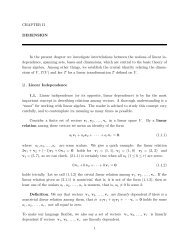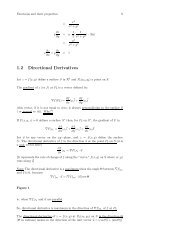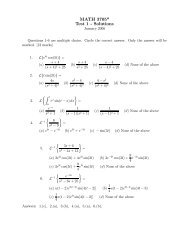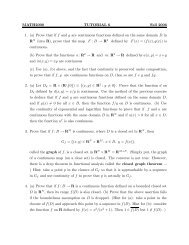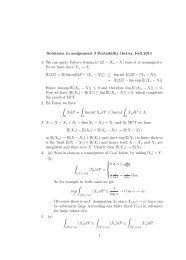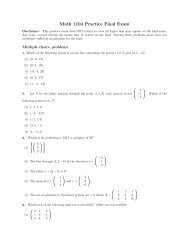TEST 1 SOLUTIONS–MATH 1102
TEST 1 SOLUTIONS–MATH 1102
TEST 1 SOLUTIONS–MATH 1102
You also want an ePaper? Increase the reach of your titles
YUMPU automatically turns print PDFs into web optimized ePapers that Google loves.
10<br />
October 10, 2012 1<br />
<strong>TEST</strong> 1 <strong>SOLUTIONS–MATH</strong> <strong>1102</strong><br />
1. Row-reduce the augmented matrix of the linear system in 3 unknowns<br />
2x2 + 2x3 = 0<br />
3x1 + 3x2 + 3x3 = 3<br />
−x1 + x3 = 1<br />
over R into RREF. Indicate every row operation clearly.<br />
Solution: The augmented matrix of this system is<br />
⎡<br />
0 2 2 0<br />
⎤<br />
⎣ 3 3 3 3 ⎦<br />
−1 0 1 1<br />
We row-reduce as follows.<br />
R1↔R2<br />
−→<br />
(1/3)R1<br />
−→<br />
R3+R1<br />
−→<br />
(1/2)R2<br />
−→<br />
R1−R2<br />
−→<br />
R3−R2<br />
−→<br />
R2−R3<br />
−→<br />
⎡<br />
⎣<br />
⎡<br />
⎣<br />
⎡<br />
⎣<br />
⎡<br />
⎣<br />
⎡<br />
⎣<br />
⎡<br />
⎣<br />
⎡<br />
⎣<br />
3 3 3 3<br />
0 2 2 0<br />
−1 0 1 1<br />
1 1 1 1<br />
0 2 2 0<br />
−1 0 1 1<br />
1 1 1 1<br />
0 2 2 0<br />
0 1 2 2<br />
1 1 1 1<br />
0 1 1 0<br />
0 1 2 2<br />
1 0 0 1<br />
0 1 1 0<br />
0 1 2 2<br />
1 0 0 1<br />
0 1 1 0<br />
0 0 1 2<br />
⎤<br />
⎦<br />
⎤<br />
⎦<br />
⎤<br />
⎦<br />
⎤<br />
⎦<br />
1 0 0 1<br />
0 1 0 −2<br />
0 0 1 2<br />
Grading: 2 for augmented matrix, 2 for correct RREF, 6 for computation.<br />
⎤<br />
⎦<br />
⎤<br />
⎦<br />
⎤<br />
⎦ .
10<br />
/10<br />
October 10, 2012 2<br />
2. Row-reduce the matrix<br />
−˙3 ˙2<br />
˙4 ˙1<br />
<br />
∈ M22(Z7)<br />
over the field Z7 into RREF. Write your final answer without any additive<br />
inverse notation (no minus signs). Indicate every row operation clearly.<br />
Solution: −˙3 = ˙4 in Z7, since ˙4 + ˙3 = ((4 + 3)mod ˙ 7) = ˙0. Therefore, the<br />
above matrix is equal to<br />
<br />
˙4 ˙2 R2−R1 ˙4 ˙2<br />
˙4 ˙1<br />
−→<br />
˙0 −˙1<br />
˙4 −1 <br />
R1 ˙1 ˙4<br />
−→<br />
−1 <br />
˙2<br />
˙0 −˙1<br />
<br />
−˙1R2 ˙1 ˙4<br />
−→<br />
−1 <br />
˙2<br />
˙0 ˙1<br />
We have used (−˙1) 2 = ˙1 in the previous step. Now, we could compute<br />
˙4 −1 = ˙2 and continue with explicit computations or we could be clever<br />
and lazy and continue with<br />
R1+(−˙4 −1 ˙2)R2<br />
−→<br />
˙1 ˙0<br />
˙0 ˙1<br />
Grading: 3 for removing additive inverse notation correctly. 4 for remaining<br />
modular arithmetic. 3 for row-reduction.<br />
3. Suppose F is a field. Using only the field axioms and a0 = 0, prove<br />
(−1)a = −a<br />
for all a ∈ F . Justify each step in your proof. (Hint: distributivity.)<br />
Solution:<br />
−1 + 1 = 0 additive inverse<br />
⇒ a(−1 + 1) = a0 multiply both side by a<br />
⇒ a(−1 + 1) = 0 given<br />
⇒ a(−1) + a1 = 0 distributivity<br />
⇒ (−1)a + a1 = 0 commutativity<br />
⇒ (−1)a + a = 0 multiplicative identity<br />
⇒ ((−1)a + a) + (−a) = 0 + (−a) add additive inverse of a<br />
⇒ (−1)a + (a + (−a)) = 0 + (−a) associativity of addition<br />
⇒ (−1)a + 0 = 0 + (−a) additive inverse<br />
⇒ (−1)a = −a additive identity<br />
Grading: 4 for justification, 2 for distributivity, 4 for correct argument.
3<br />
/3<br />
/6<br />
October 10, 2012 3<br />
4. Suppose a is an integer and n is an integer greater than 1. Provide the<br />
definition of a mod n.<br />
Solution: a mod n = r where r is the remainder with 0 ≤ r ≤ n − 1 in<br />
the equation a = qn + r guaranteed by the Division Algorithm.<br />
Grading: 1 for giving range of r.<br />
5. Suppose suppose n ≥ 2 is and integer and ˙a, ˙ b ∈ Zn. Provide the definition<br />
of the sum ˙a + ˙ b.<br />
Solution: ˙a + ˙ b = ((a + b)mod ˙ n)<br />
Grading: 1 for dot above term on right.<br />
6. Compute ˙6 + ˙6 + ˙5 in Z8 and justify each step using only the two previous<br />
definitions.<br />
Solution:<br />
˙6 + ˙6 + ˙5 = ˙<br />
((6 + 6)mod 8) + ˙5<br />
= ˙4 + ˙5 since 12 = (1)8 + 4<br />
= (4 + 5)mod ˙ 8)<br />
= ˙1 since 9 = (1)8 + 1<br />
Grading: 2 for computing addition separately. 2 for each addition.
4<br />
/10<br />
October 10, 2012 4<br />
7. Compute the standard form of the complex number e−iπ/3 . Your final<br />
answer should not contain any trigonometric functions.<br />
Solution: By definition<br />
e −iπ/3 = e i(−π/3) = cos(−π/3) + i sin(−π/3) = 1/2 − ( √ 3/2)i<br />
Grading: 2 for definition of e i(−π/3) . 2 for trigonometric identity.<br />
8. Prove by induction on n that<br />
( √ 3 + i) n = 2 n (cos(nπ/6) + i sin(nπ/6))<br />
for all integers n ≥ 1. Do not use the fact that (e iθ ) n = e inθ . You may<br />
use trigonometric identities without proof.<br />
Solution: Base case. Suppose n = 1. Then<br />
( √ 3 + i) 1 = √ 3 + i = 2( √ 3/2 + (1/2)i) = 2(cos((1)π/6) + i sin((1)π/6))<br />
and we are done.<br />
Now assume that ( √ 3 + i) n = 2 n (cos(nπ/6) + i sin(nπ/6)).<br />
For the induction step we must prove<br />
( √ 3 + i) n+1 = 2 n+1 (cos((n + 1)π/6) + i sin((n + 1)π/6)).<br />
( √ 3 + i) n+1 = ( √ 3 + i) n ( √ 3 + i)<br />
= (2 n (cos(nπ/6) + i sin(nπ/6))) (2(cos(π/6) + i sin(π/6)))<br />
Here we have used the induction assumption and the base case. We continue<br />
with<br />
= 2 n+1 (cos(nπ/6) + i sin(nπ/6))(cos(π/6) + i sin(π/6))<br />
= 2 n+1 (cos(nπ/6) cos(π/6) − sin(nπ/6) sin(π/6)<br />
+i(cos(nπ/6) sin(π/6) + sin(nπ/6) cos(π/6)))<br />
= 2 n+1 (cos((n + 1)π/6) + i sin((n + 1)π/6)).<br />
We used the identities for adding angles in cos and sin in the final step.<br />
Grading: 2 for proof of base case. 1 for induction assumption. 1 for<br />
statement of induction step. 2 for correct use of induction assumption in<br />
induction step. 4 for remaining proof of induction step.
3<br />
/3<br />
October 10, 2012 5<br />
9. Indicate whether each of the two statements below is true or false. If<br />
you think a statement is true, provide some justification. If you think a<br />
statement is false, provide a counterexample to it.<br />
(a) Suppose n is any integer greater than one (not necessarily prime).<br />
Then Zn satisfies the axiom of commutativity.<br />
Solution: True. Suppose ˙a, ˙ b ∈ Zn. Then<br />
˙a + ˙ b =<br />
(a + b)mod ˙ n = (b + a)mod ˙ n = ˙ b + ˙a<br />
since the addition of integers is commutative. Similarly,<br />
˙a ˙ b =<br />
(ab)mod ˙ n = (ba)mod ˙ n = ˙ b ˙a<br />
since the multiplication of integers is commutative.<br />
Grading: 1 for “True”. 2 for justification.<br />
(b) There is an integer n ≥ 2 such that a solution of the equation<br />
x n − 1 = 0<br />
over the complex numbers has absolute value n.<br />
Solution: False. Suppose z ∈ C is any solution to this equation.<br />
Then z n = 1 and taking absolute values of both sides we see that<br />
|z n | = |1|. We know that |z n | = |z| n and |z| ≥ 0 so the previous<br />
equation tells us that |z| n = 1 for some non-negative real number |z|.<br />
That implies that |z| = 1. We now know that the absolute value of<br />
z is 1 and 1 = n since n ≥ 2 by hypothesis.<br />
Grading: 1 for “False”. 2 for justification.


